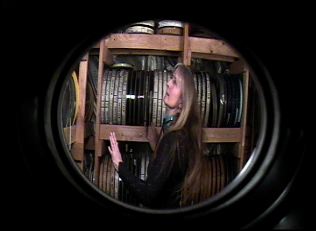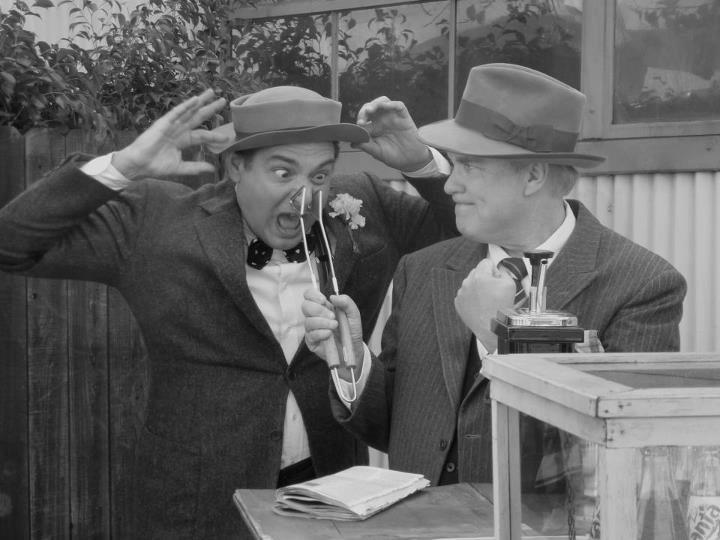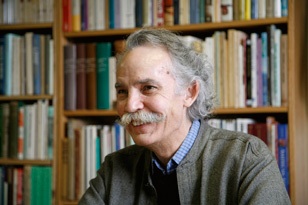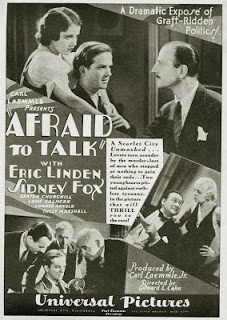
Author-historian-performer Glory-June Greiff is just the sort of multi-hyphenated person that I need to associate with, because there isn’t a lot she can’t do, except hold still.
Glory is the author of two books, Remembrance, Faith, and Fancy: Outdoor Public Sculpture in Indiana and People, Parks, and Perceptions: A History and Appreciation of Indiana State Parks. These are both available for the best prices from the author (and you can get them signed in time for Christmas!)
Not only does Glory write books, but she does one-woman shows as authors Gene Stratton-Porter andBeatrix Potter. She does presentations on the WPA and CCC, among other topics. She’s written countless National Register nominations, done treks across the country in search of odd history fragments, and she’s always the first to climb into the rafters of an endangered building to figure out how to save it.
Glory is what Ben Model calls an artrepreneur, someone who is in the arts and does a lot of things. This is both because she’s multi-talented and because artists need to be versatile in this challenging economy.
When I wrote the pilot for Dr. Film, I created the role of Anamorphia for Glory, because I knew she could play it, that she’d have fun with it, and most importantly, that she’d show up!
Glory has her own web page, which is under construction, but her blog is here. It is generally a little less ranty than mine, but you’ll probably enjoy it all the same.
•••
Q1: You’re not really a film preservationist, but you do preservation of another sort. What is it that you do?
I’m not even sure why you want to interview me, although I certainly am a rabid proponent of preserving film! My work and my passion of the past several decades, however, has been in historic preservation–the saving, interpretation, and appreciation of historic buildings, streetscapes, landscapes, and roadscapes. I am a public historian by trade.
Q2: You’re also a big believer in slide film over PowerPoint. Why?
I hate PowerPoint. I hate most PowerPoint presentations, but that’s really a different story. (You know the ones: the speaker is up there reading the words on the screen to you. It makes me scream.) PowerPoint has certain advantages, such as an interactive component, which are seldom used. I can count on one hand the PowerPoint presentations I’ve seen that could not have been done the same–or usually, better–using slides and real talk. And then they would have looked better, too. Nothing as stunning as Kodachrome slides!
By the way, in the old days I used to create slide/tape programs with all kinds of production elements, like variable pacing, background music, themes, mixed voices. I used to be radio (and radio production) so I did the narration. People would come and talk to me after saying how much they liked my “movie.” How satisfying was that!?
Q3: Weren’t you a Kodachrome die-hard?
I was. I am! I still project my beautiful Kodachrome slides for various talks I give. And yes, I shot several rolls of Kodachrome after Kodak ceased production (I had stocked up), and was among those who got the last Kodachrome processed at Dwayne’s in Kansas in December 2010. Heartbreaking. Nothing like it.
Q4: You have always been a fan of old movies. How did you get started?
Ah, well. It’s in the genes, I think. My mother loved old movies–of course to her, they were the films of her youth and held memorable associations as well. Her own mother sought escape in movies from a hard life during the Depression and World War II. My dad liked going to the movies, too. We’d bundle into the car with a pot full of popcorn on weeknights (cheaper!) and go to one of about eight drive-in theaters in our area–all the way from Michigan City to Mishawaka and Niles, Michigan–we were really blessed! The one we visited most often was only about three miles from our house on the old Lincoln Highway, but it was wiped out by a tornado when I was a kid!
Of course, that was golden age of old films being shown on television, and one was usually just starting when I arrived home from school. Mom would tell me when she first saw it and about the actors. My father liked the westerns and war stories shown at night or on weekends, which I didn’t always enjoy as much, but the adventure movies, like the Errol Flynn swashbucklers, I very much did! (I think I can still recite most of the dialogue of Captain Blood.) But the films I most cherished watching with my dad were the late Saturday night Universal horror movies and 50s sci-fi. (“They’re here! They’re here!”)
My grandparents lived next door to us when I was growing up, and between my mother’s and grandmother’s subscriptions, I think I had access to three or four film magazines. When I was in junior high, I got a subscription to Famous Monsters of Filmland. Always was a pretty weird kid.
Q5: I know that Eric really got you stuck on silent films. Do you have some favorite films or actors to recommend?
Hmm. Tough one. Lon Chaney is a genius, and Eric, who has huge collection of Chaney material, really turned me on to his work–far beyond Hunchback and Phantom, which everybody knows.
I like comedian Charley Chase, who I find to be right up there with his more well known contemporaries. “Limousine Love” is a scream! And of course, Max Davidson, largely forgotten today, is hilarious and I never miss a chance to see his films, which are best viewed, of course, with an audience.
I’ve become a huge fan of Charley Bowers, and I had never heard of him before I met Eric. Actually, I’m quite fond of several silent animators, none of whom I had known much (if anything) about before. I’m astonished at the content and effects of 1920s animation shorts and cartoons, and I wonder what these guys were smoking!
More prosaically, perhaps, I like Clara Bow a lot. And the under-appreciated Marion Davies, particularly in her non-costume roles. To ease my eyes: early Gary Cooper, hubba hubba. Buddy Rogers, ditto.
And I love Douglas Fairbanks–love how he moves! (Mind you, it was his more handsome son I noticed first, but Fairbanks, Sr. just looks like he’s having so much fun in his films!)
Q6. How do you support Eric’s film preservation work and how does he support your preservation work?
We do have a cooperative arrangement that usually works pretty well–unless we each have a gig at the same time, which happens!
And sometimes I’ve sacrificed going to events or even given up getaways; there was this time when we were going to leave for northern Michigan, and suddenly an emergency film restoration project arose. Personally, I think I should get a credit on the restored version of Seven Chances!
As a rule, I play the part of the “lovely assistant” and help Eric set up his film showings, run interference when necessary, act as shill occasionally, and answer secondary questions. I hope the best thing I do is keep encouraging his work, because I think it is important and it is not always recognized.
As for my work, Eric plays a similar part, assisting with my various programs and also coming along and helping with fieldwork and research. Sometimes we are both called to the same place; this is a usually a closed or underused theater, and Eric pokes through the projection booth while I clamber all over the building!

Q7: You’re in the Dr. Film pilot episode as Anamorphia. What was it like to play that part? You’ve been a fan of movie shows like this for a long time. How did it feel to be in one?
You know, these are wonderful questions. I had a dream since I was a teen of doing a sort of vampire woman horror-host TV show–bear in mind I had never seen Vampira or Elvira. (I grew up in northern Indiana.) I worked in radio for some years and never had much thought to venture into TV–unless the opportunity had arisen to do a gig like that!
So this is the closest I’ve gotten to it. I do think my director has me go a little too over-the-top, but maybe that’s appropriate!
It’s fun; I love doing theater of any sort–and I wish someone would pick up Dr. Film so we could shoot more episodes!
Q8: You’re a big supporter of the Dr. Film show, and you want Eric to keep trying to get it out there. You even wrote a guest blog about it. What makes you so passionate about the show? You seem even more gung-ho about it than Eric is.
That was a nice segue from the previous question, wasn’t it? I don’t know, maybe it’s because I have been working in field where you simply don’t always win–in fact, often do not–but you just have to pick up and keep trying because it’s the right thing to do–and you must pursue your passion.
Dr. Film is the kind of show that SHOULD be out there–more so now than ever, I think. I grew up just knowing about a lot of movies just because they were THERE–but they aren’t there anymore. We are losing our cultural references. And anyway, film history is fun!
Q9: What are some of the craziest things you’ve done to get things preserved, either in the film world or otherwise? I hear you’re pretty dedicated sometimes.
Crazy things? Why, what do you mean? Well, one of my very first preservation efforts involved a beautiful early 1900s office building in downtown Indianapolis. I set up pickets with signs and a petition campaign. We made the newspapers, but didn’t win; the forces against preservation were too great. But you have to keep trying.
A year or two later I spearheaded a campaign to save a beautiful abandoned New Deal-era apartment complex. We did guerilla renovation on one apartment and brought everyone we could out there to see it to try to change the minds of the powers-that-be. It took four months of my life, full time, but that remains one of my proudest efforts–even though we didn’t win. Those apartments were built to last; it took the city months to tear them down at far greater cost than they thought. Ha!
To this day I am known to run wildly into abandoned buildings and dance along abandoned stretches of old highways. As for film, how many times have I ridden in a car full of film that smells like a salad? (That would be indicative of vinegar syndrome.) And about that time I gave up my trip to northern Michigan. . .
10. What question did I not ask you that I should have asked? And answer that question, please.
Why do you dance all the time?
Why do you breathe? (Thanks to The Red Shoes.)
Why do I take the old roads and shun interstates? Same answer.








